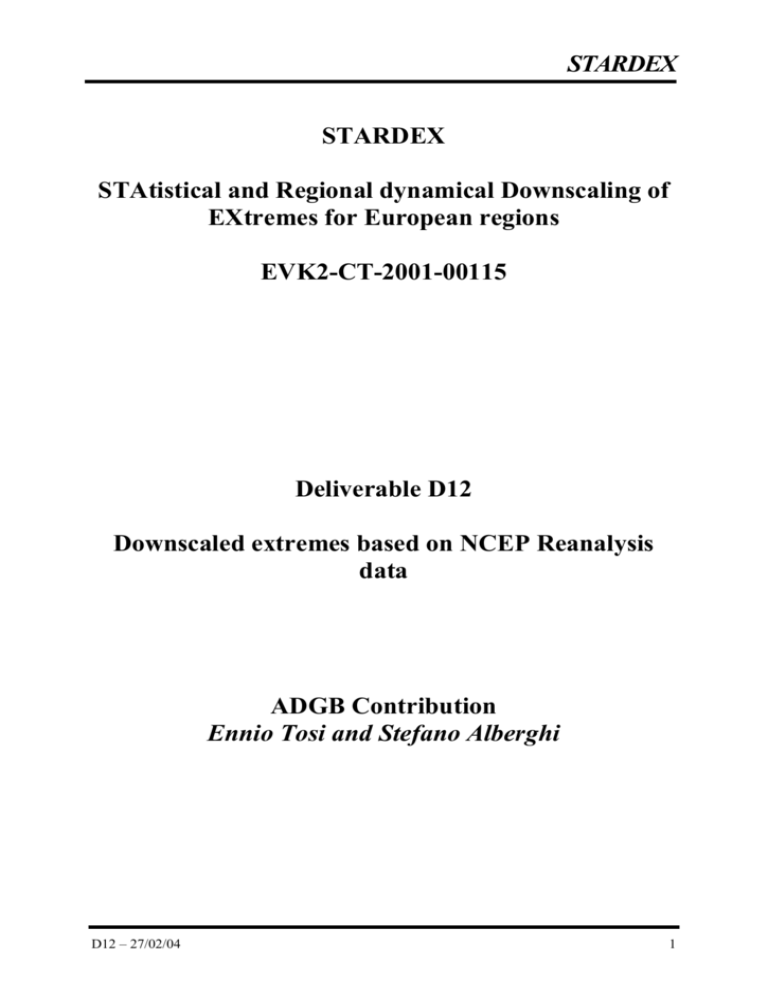D12_ADGB
advertisement

STARDEX STARDEX STAtistical and Regional dynamical Downscaling of EXtremes for European regions EVK2-CT-2001-00115 Deliverable D12 Downscaled extremes based on NCEP Reanalysis data ADGB Contribution Ennio Tosi and Stefano Alberghi D12 – 27/02/04 1 STARDEX ADGB Downscaling Model The assumptions at the base of the method derive from the consideration that the observations at a single station are too much influenced by local weather conditions to be sufficiently correlated to large scale parameters, and that, due to the high small scale variability of the topography in Northern Italy, the precipitation field is highly variable in space. The consequences of this high variability are that some areas, like the delta of the river Po, have a 90th percentile of 16 mm while the areas of maximum precipitation, the area between Switzerland and Italy around the lake of Como, the area between Austria, Slovenia and Italy, and the eastern side of the gulf of Genoa have the 90th percentile of 42 mm. The characteristics of the extreme events are therefore quite different, and the occurrence of an event in an area may be associated to “normal” precipitation in another area. Moreover two very similar large scale patterns can produce extreme events in different areas, usually the areas where the mean precipitation is higher. To have a good compromise between good links with large scale parameters, and good representation of small scale precipitation features, the model uses a single index of precipitation for all Northern Italy, which has a strong link with large scale predictors and a good correlation with extreme precipitation events over Northern Italy. Index chosen is the sum of squares of the first two adimensional PCs of rain on Northern Italy, computed using the gridded data produced by ETH. This is a daily index, and it has been computed from 1966 to 1990, beyond this interval rain data on Italy become unreliable. As figs 1 and 2 show, high values of PC1 give maximum precipitations both in the Western and Eastern part of Northern Italy, high values of PC2 give high precipitation in the West or in the East, depending on the sign. Figures 1-2 – EOF1 and EOF2 of total precipitation, each multiplied by the root of its eigenvalue. D12 – 27/02/04 2 STARDEX 1. Method The definition of the events takes into account that we are interested in precipitation extremes linked to large scale circulation patterns and therefore associated with synoptic scale systems, and not deriving from intense convection associated with thunderstorms. The identification of a day with precipitation is made in two steps: first it is required the presence of at least 1 mm of rain in 25 adjacent grid points, second, considering that the grid point value is obtained by interpolating station values, and therefore a high value is “distributed” over nearby grid points, isolated precipitation peaks have been eliminated if their value is greater than 4 times the minimum value of the 8 closest points. If there are only isolated (as defined above) precipitations the day is classified as a no rainy day. The precipitation value for a day classified as precipitation day is the maximum over the whole area. This procedures produces a series of daily precipitation values and the 95th percentile value has been chosen as the threshold for extreme precipitation. Extreme events occur when large scale parameters fall into a reduced range of values, the choice of the 95th percentile allows a significant restriction of this range. The predictand has been chosen considering that the first two principal components of the precipitation over Northern Italy have a strong relation with the extreme precipitation events, that are always located in correspondence of the maxima of the two PC. The correlation between large scale features and the amplitude of the two PC is good. The square root of the sum of the squares of the two PC is strongly linked to intensity of the precipitation, the correlation coefficient is .85, and, therefore has been chosen as predictand. The method derives separately the amplitude of PC1 and PC2, and the predictand is computed afterwards. The choice of the predictors has been made firstly considering that when extreme events occur, large scale parameters fall into a reduced range of values. Specifically: the GPH anomalies at 500 hPa around the point of maximum correlation are below 60 m. The relative humidity at 700 hPa in the point of maximum correlation is above 33%. The geostrophic wind at 500 hPa over Northern Italy comes from South-West. The 500-1000 thickness gradient is directed in a North- South direction. The total precipitable water is above 13 mm. The selection criteria for the 95th percentile are more restrictive than those for 90th. These selection criteria allow to decide a priori if a precipitation extreme can occur in a given day. The choice of the large scale parameters to be used for the selection of the days has been made a priori taking into account the fact that high precipitation events are usually associated with cyclogenesis in the lee of the Alps, and relative humidity and precipitable water have been added to add information about the saturation state of the atmosphere and the amount of water available. After the choice their effective selection capability has been tested. The determination of the grid points to be used for the values of the predictors cannot be made only using linear correlation coefficient. For instance the direction of the geostrophic wind at 500 hPa, being a periodic parameter, does not correlate with PC1 or PC2, the scatter plot shows points crowding in correspondence of the South-West direction showing that there is a non linear dependence of the amplitude of the PCs from the direction of the wind. The points to be used have therefore been chosen analyzing the scatter plots and selecting the D12 – 27/02/04 3 STARDEX point whose plots showed the highest variation of the PC amplitude as a function of the parameter under examination. The verification of the predictive ability of the predictors has been made using them separately and then, starting with the most powerful, introducing one predictor at a time to test an effective increase of prediction skill. At the end of the procedure the 4 predictors chosen are GPH anomalies at 500 hPa, relative humidity at 700 hPa, geostrophic wind at 500 hPa and precipitable water. The grid points used for each predictor vary for the two PCs. The downscaling method begins with the selection of the days with condition favorable for high precipitation. If the large scale parameters are in requested range their values identify a point in the 4 dimensional hyper space of the 4 predictors. The distribution of observed PC amplitude in the neighborhood of this point varies as a function of the region. An histogram is constructed with the PC amplitudes contained inside a hyper sphere in the space of predictors whose radius is chosen to contain 150 points. Various bin size of the histogram have been tested to assure stability of the results. Given the histogram, a value is chosen for the PC amplitude using a random number generator. The results of the model are sensitive to the choice of the random number, as expected for rare events, so the results are given as a mean of 99 runs of the model. It has been chosen to use always full year data, without considering different seasons. The main reasons are that during summer the total number of data is reduced, and therefore the exclusion of some years for testing the downscaling method could produce a statistic too poor. The second reason is that introducing a season dependent statistic based on observed seasons forces the observed annual cycle of future climate scenarios, and does not allow to detect shifts of the annual cycle. As already mentioned, the precipitation data on Italy are unreliable after 1990, thus, to have a sufficient statistic to compute skills (e.g. rank correlation), all the years from 1966 to 1990 have been downscaled for verification one at a time, using in turn the remaining 24 years for training. 2. Results Results are summarized in figs. 3-6 for the various seasons and in fig. 7 for the whole year. The quantity shown is the numbers of occurrences of events exceeding the 90th percentile threshold of our indicator computed from observed precipitation (continuous line) and predicted by the downscaling method using NCEP data (dotted line). Table 1 shows bias, root mean square error and correlation for the same quantity plotted in the figures. The model is based on a pre-selection of days favourable to extreme precipitations, therefore it produces a non-continuous time series of values for the downscaled index. It is not possible to produce indexes like consecutive dry days The different seasons show results not homogeneous, ranging from very good for spring and winter, with good agreement testified both by a small bias and high correlation, good for autumn and for summer. During autumn most of the errors derives from the failure of the model to reproduce the high variability shown by observations in the period 1975-1980, while the other years are better reproduced, the correlation coefficient is .51. Summer is the more D12 – 27/02/04 4 STARDEX problematic, since it shows a low correlation coefficient. The use of the whole year data statistic for the prediction of the indicator, given the values of the predicting parameters, is the most probable candidate for the explanation of this behavior. The results for the year are strongly influenced by the varying performances of the model during the different seasons. Figures 3-6 - Skill model results for the four seasons: number of extreme precipitation events annual series (observed and downscaled) Figure 7 - Skill model results for the whole year index series D12 – 27/02/04 5 STARDEX No. of events > long-term 90th percentile of rain days YEAR DJF MAM JJA SON BIAS RMSE CORR BIAS RMSE CORR BIAS RMSE CORR BIAS RMSE CORR BIAS RMSE CORR -0.80 7.17 0.20 -0.68 2.13 0.61 0.54 2.79 0.73 1.29 2.66 0.37 -1.95 3.92 0.62 Table 1 – Skill of the model D12 – 27/02/04 6







